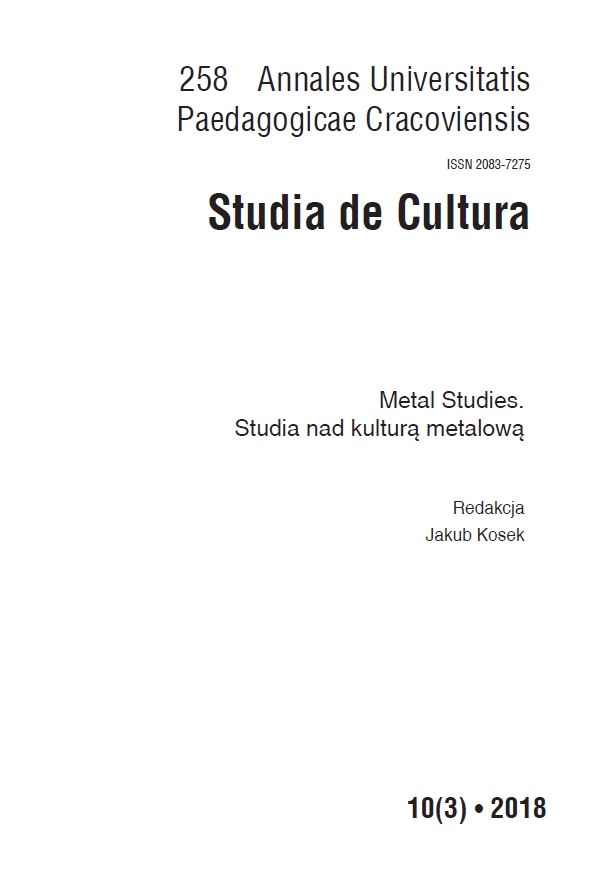Abstrakt
DOI 10.24917/20837275.10.3.5
Artykuł dotyczy swoistej „podwójnej” twórczości muzyków związanych z zespołem Neurosis i projektem Tribes of Neurot. Obie formacje tworzą ci sami artyści, płyty obu zespołów stanowią dwie, radykalnie różne wersje tych samych kompozycji. Materiałem badawczym jest tu relacja między płytami Times of Grace Neurosis oraz Grace Tribes of Neurot (1999). Obie płyty, choć niezależne, słuchane równocześnie stanowią niezwykle ciekawą nową wartość artystyczną. Artykuł skupia się na analizie brzmienia oraz swoistej „lustrzaności” kompozycji obu zespołów, której celem jest interpretacja artystycznych i światopoglądowych implikacji zabiegu zaproponowanego przez muzyków Neurosis.
Synchronous alter-ego. Doubling and alternative in the work of Neurosis and Tribes of Neurot
This paper concerns at ”doubleness” in work of Neurosis and Tribes of Neurot. The activity of both groups seems to be simultaneous: the same artists in the both bands, the same names of their albums, the same trakclists, similar cover designs suggest to treat it not as different ventures but as a significant dual artistic project. Parallel between simultaneous albums of Neurosis and Tribe of Neurot makes an impression of disturbing presence of unclear alterego in their music.
Bibliografia
Deller Alex. 2016. “Neurosis: ‘Crass were the mother of all bands’”. The Guardian [3.11.2016]
Zobacz w Google Scholar
https://www.theguardian.com/music/musicblog/2016/nov/03/neurosis-crassbands-anarcho-punk-steve-von-till [dostęp: 20.09.2017].
Zobacz w Google Scholar
Freud Sigmund. 1997. Niesamowite. W Pisma psychologiczne, t. 3, cz. 11. Warszawa.
Zobacz w Google Scholar
Grow Kory. 2016. “Neurosis on 30 Years of Finding ‘New Ways of Being Heavy’”. Rolling Stone (22.11.2016). http://www.rollingstone.com/music/features/neurosis-on-30-years-offinding-new-ways-of-being-heavy-w445282 [dostęp: 20.09.2017].
Zobacz w Google Scholar
Neurosis. 1999. Times of Grace (wkładka), Relapse Records.
Zobacz w Google Scholar
Neurosis. (band) (hasło). W Wikipedia. http://en.wikipedia.org/wiki/Neurosis_(band) [dostęp: 22.09.2017].
Zobacz w Google Scholar
Neurosis (hasło). W Discogs.com. https://www.discogs.com/artist/154935-Neurosis [dostęp: 22.09.2017].
Zobacz w Google Scholar
Neurosis (hasło). W Encyclopedia Metalum. https://www.metal-archives.com/bands/Neurosis/60 [dostęp: 22.09.2017].
Zobacz w Google Scholar
Schaeffer Pierre. 2010. Akuzmatyka. J Kutyła (przeł.). W Kultura dźwięku, Ch. Cox, D. Warner (red.). Gdańsk. 106–112.
Zobacz w Google Scholar
Sharpe-Young Garry. 2005. “New Wave of American Heavy Metal. New Plymouth”.
Zobacz w Google Scholar
Silver Blood Transmission. http://www.allmusic.com/album/silver-blood-transmission-mw0000645016 [dostęp: 20.09.2017].
Zobacz w Google Scholar
Thomson Jamie 2010. “How Neurosis blazed a trail for ‘thinking man’s metal’ and lasted 25 years”. The Guardian (2.12.2010). https://www.theguardian.com/music 2010/dec/02/neurosis-live-at-roadburn/ [dostęp: 20.09.2017].
Zobacz w Google Scholar
“Through Silver in Blood”. http://www.allmusic.com/album/through-silver-in-bloodmw0000647779 [dostęp: 20.09.2017].
Zobacz w Google Scholar
“Times of Grace”. http://www.allmusic.com/album/times-of-grace-mw0000046552; [dostęp: 20.09.2017].
Zobacz w Google Scholar

